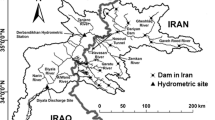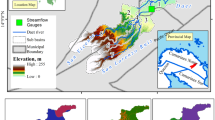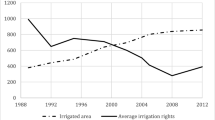Abstract
In many semi-arid and arid regions of the world, water saving strategies need to be implemented in the agricultural sector in order to increase the resilience to water scarcity. We investigate basin-scale hydrological impacts of possible irrigation technique improvements, considering extensive cotton fields in the Aral Sea drainage basin (ASDB), Central Asia. We use a distributed hydrologic model that combines basin-scale, calibrated discharge and evapotranspiration quantifications with experimental results of (on-farm) water application needs for different irrigation techniques. This allows for quantification of how return flows contribute to river discharge through coupled groundwater-surface water-systems at the basin scale, under different regional climatic conditions. Results show that an implementation of improved irrigation techniques can yield water savings that increase the discharge to the Aral Sea by between 1 and 6 km3/year. Such water savings could contribute to mitigation of the acute water scarcity in the lower ASDB. The basin-scale water savings are about 60% lower than corresponding on-farm reductions in irrigation water application, since water is re-used and, hence, return flows decrease when less water is applied. Spatial analysis of regional differences in climatic conditions shows that implementation of more efficient irrigation systems would result in much larger (up to a factor 4) water savings in the more arid downstream regions than in the colder, upstream mountainous regions.
Similar content being viewed by others
References
Abdullaev I, Molden D (2004) Spatial and temporal variability of water productivity in the Syr Darya Basin, central Asia. Water Resour Res 40(3):W08S02
Abdullaev I, Giordano M, Rasulov A (2007) Cotton in Uzbekistan: Water and Welfare. In: Kandiyoti D (ed) The cotton sector in Central Asia. SOAS, University of London, London, pp 102–118
Aldaya MM, Munoz G, Hoekstra AY (2010) Water footprint of cotton, wheat and rice production in Central Asia. Value of Water Research Report Series No. 41. Delft, Netherlands
Andersson L, Wilk J, Todd MC, Hughes DA, Earle A, Kniveton D, Layberry R, Savenije H (2006) Impact of climate change and development scenarios on flow patterns in the Okavango River. J Hydrol 331:43-57
Asokan SM, Jarsjö J, Destouni G (2010) Vapor flux by evapotranspiration: Effects of changes in climate, land use, and water use. J Geophys Res 115:D24102. doi:10.1029/2010JD014417
Australian Government National Water Commission (2007) Australian Water Resources 2005: A baseline assessment of water resources for the National Water Initiative, Level 2 assessment, Water availability theme, National perspective, report, Natl. Water Comm.,Canberra, ACT, Australia.
Batjes NH (2005) ISRIC-WISE global data set of derived soil properties on a 0.5 by 0.5 degree grid (Version 3.0). Report 2005/08. ISRIC-World Soil Information, Wageningen
Bayer-Raich M, Jarsjö J, Liedl R, Ptak T, Teutsch G (2006) Integral pumping test analyses of linearly sorbed groundwater contaminants using multiple wells: Inferring mass flows and natural attenuation rates. Water Resour Res 42:W08411. doi:10.1029/2005WR004244
Bucknall J, Klytchnikova I, Lampietti J, Lundell M, Scatasta M, Thurman M (2003) Irrigation in Central Asia: social, economic and environmental considerations. World bank report. http://go.worldbank.org/G0J1DNKDO0. Accesed 26 January 2011
Cai X, McKinney DC, Rosegranta MW (2003) Sustainability analysis for irrigation water management in the Aral Sea region. Agric Syst 76:1043–1066
Cetin O, Bilgel L (2002) Effects of different irrigation methods on shedding and yield of cotton. Agric Water Manag 54:1-15
Destouni G, Asokan SM, Jarsjö J (2010a) Inland hydro-climatic interaction: Effects of human water use on regional climate, Geophys Res Lett 37:L18402. doi:10.1029/2010GL044153
Destouni G, Persson K, Prieto C, Jarsjö J (2010b) General quantification of catchment-scale nutrient and pollutant transport through the subsurface to surface and coastal waters. Environ Sci Technol 44:2048–2055
FAO (2003) Review of world water resources by country. Margat J, Frenken K, Faurès JM (2005) Key water resources statistics in Aquastat. Water reports 23. ISSN 1020-1203. Food and Agriculture Organization of the United Nations, Rome
Gordon LJ, Peterson GD, Bennett EM (2008) Agricultural modifications of hydrological flows create ecological surprises. Trends Ecol Evol 23(4):211–219. doi:10.1016/j.tree.2007.11.011
Glantz M (1999) Creeping environmental problems and sustainable development in the Aral Sea basin. Cambridge University Press, Cambridge
Horst MG, Shamutalov SS, Gonçalves JM, Pereira LS (2007) Assessing impacts of surge-flow irrigation on water saving and productivity of cotton. Agric Water Manag 87:115–127
Ibragimov N, Evett SR, Esanbekov Y, Kamilov BS, Mirzaev L, Lamers JPA (2007) Water use efficiency of irrigated cotton in Uzbekistan under drip and furrow irrigation. Agric Water Manag 90:112–120
Intergovernmental Panel on Climate Change (2007) Climate change 2007: synthesis report. In: Pachauri RK, Reisinger A (eds) contribution of working groups I, II and III to the fourth assessment report of the intergovernmental panel on climate change, Geneva, Switzerland
Ismail SH (2006) Effect of tillage on water advance and distribution under surge and continuous furrows irrigation methods for cotton in Egypt. Irrig Drain 55:191–199
Ismail S, Depeweg H, Schultz B (2004) Surge flow irrigation under short field conditions in Egypt. Irrig and Drai 53:461–47
Jarsjö J, Shibuo Y, Destouni G (2008) Spatial distribution of unmonitored inland water discharges to the sea. J Hydrol 348(1–2):59–72
Johansson O, Aimbetov’ I, Jarsjö J (2009) Variation of groundwater salinity in the partially irrigated Amudarya River delta, Uzbekistan. J Marine Syst 76(3):287–295
Kanber R, Köksal H, Önder S, Kapur S, Sahan S (2001) Comparison of surge and continuous furrow methods for cotton in the Harran plain. Agric Water Manag 47:119–135
Khan S, Abbas A, Gabriel HF, Rana T, Robinson D (2008) Hydrologic and economic evaluation of water-saving options in irrigation systems. Irrig Drain 57:1–14
Langbein WB (1949) Annual runoff in the United States, U. S. Geol Surv Circ 52
Lankford B (2006) Localising irrigation efficiency. Irrig Drain 55:345–362
Lioubimtseva E, Henebry GM (2009) Climate and environmental change in arid Central Asia: impacts, vulnerability, and adaptations. J Arid Environ 73:963–977. doi:10.1016/j.jaridenv.2009.04.022
Lobell D, Bala G, Mirin A, Phillips T, Maxwell R, Rotman D (2009) Regional Differences in the Influence of Irrigation on Climate, J Clim 22(8):2248-2255. doi:10.1175/2008JCLI2703.1
Mamatov S (2003) Study of the groundwater contribution to the aral sea region water supply and water quality: strategies for reversibility and pollution control-INTAS project 1014. EU-INTAS Aral Sea Basin Call 2000, Group CR5 status report of April 30, 2003
Maneta MP, Torres M, Wallender WW, Vosti S, Kirby M, Bassoi LH, Rodrigues LN (2009) Water demand and flows in the Saõ Francisco River Basin (Brazil) with increased irrigation. Agric Water Manag 96:1191–1200
Mateos L, Berengena J, Orgaz F, Diz J, Fereres E (1991) A comparison between drip and furrow irrigation in cotton at two levels of water supply. Agric Water Manag 19:313–324
Meigh JR, McKenzie AA, Sene KJ (1999) A grid-based approach to water scarcity estimates for eastern and southern Africa. Water Resour Manag 13(2):85–115
Mitchell TD, Jones PD (2005) An improved method of constructing a database of monthly climate observations and associated highresolution grids. Int Climatol 25:693–712
Molden D, Frenken K, Barker R et al (2007) Trends in water and agricultural development. In: Molden D (ed) Water for food, water for life: a comprehensive assessment of water management in agriculture. Earthscan, London, pp 57–89
Periera LS, Oweis T, Zairi A (2002) Review: irrigation management under water scarcity. Agric Water Manag 57:175–206
Ragab R, Prudhomme C (2002) Climate change and water resources management in arid and semi-arid regions: prospective and challenges for the 21st century. Biosyst Eng 81(1):3–34. doi:10.1006/bioe.2001.0013
Rajak D, Manjunatha MV, Rajkumar GR, Hebbara M, Minhas PS (2006) Comparative effects of drip and furrow irrigation on the yield and water productivity of cotton (Gossypium hirsutum L.) in a saline and waterlogged vertisol. Agric Water Manag 83:30–36
Rakhmatullaev S, Huneau F, Kazbekov J, Le Coustumer P, Jumanov J, El Oifi B, Motelica-Heino M, Hrkal Z (2010) Groundwater resources use and management in the Amu Darya River Basin (Central Asia). Environ Earth Sci 59(6):1183–1193
Rost S, Gerten D, Bondeau A, Lucht W, Rohwer J, Schaphoff S (2008) Agricultural green and blue water consumption and its influence on the global water system. Water Resour Res 44(9):W09405. doi:10.1029/2007WR006331
Saiko TS, Zonn IS (2000) Irrigation expansion and dynamics of desertification in the Circum-Aral region of Central Asia. Appl Geogr 20:349–367
Shibuo Y, Jarsjö J, Destouni G (2007) Hydrological responses to climate change and irrigation in the Aral Sea drainage basin. Geophys Res Lett 34:L21406. doi:10.1029/2007GL031465
Siebert S, Döll P, Hoogeveen J, Faures JM, Frenken K, Feick S (2005). Development and validation of the global map of irrigation areas. Hydrol Earth Syst Sci 9:535–547
Su YH, Zhu GF, Feng Q, Li, ZZ, Zhang FP (2009) Environmental isotopic and hydrochemical study of groundwater in the Ejina Basin, northwest China. Environ Geol 58:601–614
Thomas RJ (2008) Opportunities to reduce the vulnerability of dryland farmers in Central and West Asia and North Africa to climate change. Agric Ecosyst Environ 126:36–45. doi:10.1016/j.agee.2008.01.011
Turc L (1954) ‘The water balance of soils,’ Relation between precipitation evaporation and flow. Ann Agron 5:491–569
Törnqvist R, Jarsjö J (2011) Reduction of Water Losses by use of Alternative Irrigation Techniques in the Aral Sea Drainage Basin. In: Behnassi M, D’Silva J, Shabbir SA (eds) Sustainable agricultural development: sustainable agricultural development—recent approaches in resources management and environmentally-balanced production enhancement. ISBN: 978-94-007-0518-0. Springer, Dordrecht, pp 157–168
Törnqvist R, Jarsjö J, Karimov B (2011) Health risks from large-scale water pollution: trends in central Asia. Environ Int 37(2):435–442. doi:10.1016/j.envint.2010.11.006
United States Department of Agriculture (2009) Cotton: World markets and trade. Foreign agricultural service, office of global analysis circular series FOP 04-09 April 2009. http://www.fas.usda.gov/cotton_arc.asp. Accessed 26 January 2011
Ünlü M, Kanber R, Onder S, Sezen M, Diker K, Ozekici B, Oylu M (2007) Cotton yields under different furrow irrigation management techniques in the Southeastern Anatolia Project (GAP) area, Turkey. Irrig Sci 26:35–48
Verstraeten WW, Veroustraete F, Heyns W, Roey TV, Feyen J (2008) On uncertainties in carbon flux modeling and remotely sensed data assimilation: the Brasschaat pixel case. Adv Space Res 41:20–35. doi:10.1016/j.asr.2007.08.021
Yakubov M, Manthrithilake H (2009) Water for food as food for thought: case study of applying the Podiumsim model to Uzbekistan. Irrig Drain 58:17–37
Author information
Authors and Affiliations
Corresponding author
Electronic Supplementary Material
Below is the link to the electronic supplementary material.
Rights and permissions
About this article
Cite this article
Törnqvist, R., Jarsjö, J. Water Savings Through Improved Irrigation Techniques: Basin-Scale Quantification in Semi-Arid Environments. Water Resour Manage 26, 949–962 (2012). https://doi.org/10.1007/s11269-011-9819-9
Received:
Accepted:
Published:
Issue Date:
DOI: https://doi.org/10.1007/s11269-011-9819-9




